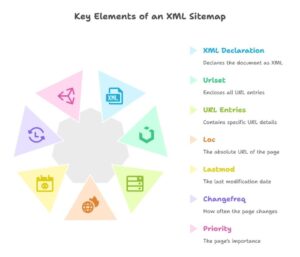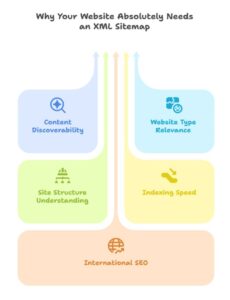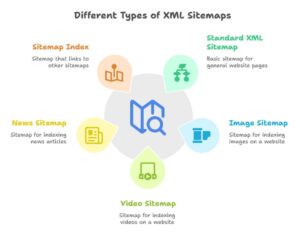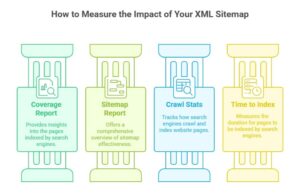Contents
- 1 What Exactly is an XML Sitemap?
- 2 Why Your Website Absolutely Needs an XML Sitemap
- 3 Different Types of XML Sitemaps (And When to Use Them)
- 4 Which Pages Should (and Shouldn’t) Be in Your XML Sitemap?
- 5 How to Create and Implement an XML Sitemap on Your Website
- 6 Common XML Sitemap Mistakes to Avoid
- 7 How to Measure the Impact of Your XML Sitemap
- 8 Real-World Examples: XML Sitemaps in Action
- 9 Recommended Visuals to Enhance This Article
- 10 XML Sitemaps and Future SEO Trends
- 11 Conclusion: XML Sitemaps as Your Website’s GPS for Search Engines
- 12 Frequently Asked Questions About XML Sitemaps
- 12.1 1. Do XML sitemaps directly improve search rankings?
- 12.2 2. How often should I update my XML sitemap?
- 12.3 3. Can having multiple sitemaps hurt my SEO?
- 12.4 4. What if some of my pages aren’t appearing in my automatically generated sitemap?
- 12.5 5. Are the priority and changefreq attributes still important?
- 12.6 6. Should I include pagination pages in my XML sitemap?
- 12.7 7. Do I need a sitemap if my site has good internal linking?
- 12.8 8. What’s the difference between the sitemap for users and the XML sitemap for search engines?
- 12.9 9. Can I submit the same sitemap to multiple search engines?
- 12.10 10. Will an XML sitemap help fix crawl errors on my site?
Have you ever built an incredible website with fantastic content, only to watch it sit in the shadows of Google’s search results? You’re not alone. Many website owners pour their hearts into creating valuable content, yet struggle to get the visibility they deserve.
It’s like throwing a party in a labyrinth – your guests (search engines) know you’re hosting something great, but they can’t find their way to you.
This is where XML sitemaps come to the rescue. While they might sound like a dry technical concept, they’re actually the unsung heroes of your website’s visibility strategy. Think of an XML sitemap as leaving a trail of breadcrumbs that leads search engines directly to your most valuable content – no wandering, no missed pages, just efficient discovery.
In this guide for beginners at guide.zuptek.com, I’ll walk you through everything you need to know about XML sitemaps – from understanding what they actually are to implementing them effectively on your own website. By the end, you’ll see why this seemingly small technical element can make a dramatic difference in your site’s search engine visibility.
What Exactly is an XML Sitemap?
An XML sitemap is a special file that provides search engines with a roadmap of your website’s structure. Written in Extensible Markup Language (XML), it lists all the important pages on your site that you want search engines to discover and index.
Unlike standard HTML sitemaps that are designed for human visitors, XML sitemaps are specifically created for search engine crawlers like Googlebot. They’re essentially a direct communication channel between your website and search engines.
Here’s what a basic XML sitemap entry looks like:
<?xml version="1.0" encoding="UTF-8"?>
<urlset xmlns="http://www.sitemaps.org/schemas/sitemap/0.9">
<url>
<loc>https://guide.zuptek.com/what-is-seo/</loc>
<lastmod>2025-05-10</lastmod>
<changefreq>monthly</changefreq>
<priority>0.8</priority>
</url>
</urlset>
Let’s break down the key elements:
- XML declaration:
<?xml version="1.0" encoding="UTF-8"?>tells search engines this is an XML document. - Urlset: The root element that encloses all URL entries and defines the XML namespace.
- URL entries: Each containing:
- loc: The absolute URL of the page (mandatory)
- lastmod: When the page was last modified (optional but highly recommended)
- changefreq: How often the page typically changes (optional)
- priority: The relative importance compared to other URLs on your site (optional)
While all these elements have their place, Google has specifically mentioned that the lastmod date is particularly important. According to Google’s Gary Illyes:
“The <lastmod> element in sitemaps is a signal that can help crawlers figure out how often to crawl your pages.”
This makes logical sense – if Google knows exactly when you’ve updated a page, it can prioritize recrawling that content rather than pages that haven’t changed in years.
Why Your Website Absolutely Needs an XML Sitemap
Now that you understand what XML sitemaps are, let’s talk about why they’re so crucial for your website’s visibility in search engines.

1. They Make Your Content More Discoverable
The internet is massive and growing larger every day. Search engines have limited resources (known as “crawl budget”) to discover and index content. Without clear guidance, they might:
- Miss important pages buried deep in your site structure
- Waste resources crawling less important pages
- Take much longer to discover your newest content
Real-world scenario: You’ve just published an incredible guide on “Advanced On-Page SEO Techniques” that could genuinely help your audience. Without a sitemap, Google might take weeks to discover this content if it’s not prominently linked from your homepage. With an updated XML sitemap, you’re essentially saying, “Hey Google, I just created this valuable new resource – please check it out!”
2. They’re Especially Crucial for Certain Types of Websites
While all websites benefit from XML sitemaps, they’re particularly important if your site has any of these characteristics:
- New websites with few backlinks: Without established authority and links pointing to your content, search engines need extra help finding your pages.
- Large websites with many pages: The more content you have, the more important it becomes to organize it clearly for search engines.
- Sites with a complex structure: If important pages are several clicks away from the homepage, they might get overlooked without a sitemap.
- Content-heavy sites that update frequently: News sites, blogs, or e-commerce stores with regularly changing inventory need to signal these updates effectively.
- Sites with orphaned pages: Pages with few or no internal links pointing to them may never be discovered without a sitemap.
For your growing Zuptek SEO Guide blog, a sitemap is becoming increasingly important as you add more in-depth articles on technical SEO topics.
3. They Help Search Engines Understand Your Site Structure
Beyond simply listing URLs, sitemaps provide context about your website’s information architecture. Through properly structured sitemaps, search engines can understand:
- The hierarchical relationship between pages
- Which content is most important (through your homepage and main category pages)
- How different sections of your site relate to each other
This structural understanding can influence how search engines interpret the relevance and authority of different sections of your website.
4. They Speed Up the Indexing of New and Updated Content
When you publish new content or make significant updates, you want search engines to know about it immediately. By updating your XML sitemap’s lastmod dates and resubmitting it through Google Search Console, you’re sending a clear signal that something has changed.
This process can significantly reduce the time between publishing and appearing in search results – a crucial advantage in competitive niches where being first with information matters.
5. They Help with International and Multilingual SEO
If your site targets multiple countries or languages, specialized XML sitemaps help search engines understand these relationships:
<url>
<loc>https://guide.zuptek.com/what-is-seo/</loc>
<xhtml:link rel="alternate" hreflang="es" href="https://guide.zuptek.com/es/que-es-seo/" />
<xhtml:link rel="alternate" hreflang="fr" href="https://guide.zuptek.com/fr/quest-ce-que-le-seo/" />
</url>This structure helps search engines serve the right language version to users in different regions.
Different Types of XML Sitemaps (And When to Use Them)
As websites grow in complexity, different types of sitemaps become necessary to properly organize your content for search engines.

1. Standard XML Sitemap
This is the basic sitemap format we’ve discussed, which can contain up to 50,000 URLs and must be under 50MB when uncompressed. For most small to medium websites, a standard XML sitemap is sufficient.
2. Image Sitemap
If your website heavily relies on visual content (like a photography portfolio, recipe blog, or product catalog), image sitemaps help search engines discover and understand your images:
<url>
<loc>https://guide.zuptek.com/technical-seo-guide/</loc>
<image:image>
<image:loc>https://guide.zuptek.com/images/technical-seo-diagram.jpg</image:loc>
<image:title>Technical SEO Framework Diagram</image:title>
<image:caption>Comprehensive breakdown of technical SEO components</image:caption>
</image:image>
</url>This additional context helps your images appear in Google Image Search and other visual search engines.
3. Video Sitemap
For websites with video content, video sitemaps provide crucial metadata that can help your videos appear in video search results:
<url>
<loc>https://guide.zuptek.com/how-to-create-backlinks/</loc>
<video:video>
<video:thumbnail_loc>https://guide.zuptek.com/videos/backlink-tutorial-thumb.jpg</video:thumbnail_loc>
<video:title>How to Create Quality Backlinks: Step-by-Step Tutorial</video:title>
<video:description>Learn proven techniques for building high-quality backlinks to improve your website's authority.</video:description>
<video:content_loc>https://guide.zuptek.com/videos/backlink-tutorial.mp4</video:content_loc>
<video:duration>360</video:duration>
</video:video>
</url>Video sitemaps are especially important because video content is harder for search engines to analyze without additional context.
4. News Sitemap
If you regularly publish news content and want it included in Google News:
<url>
<loc>https://guide.zuptek.com/latest-seo-algorithm-update/</loc>
<news:news>
<news:publication>
<news:name>Zuptek SEO Guide</news:name>
<news:language>en</news:language>
</news:publication>
<news:publication_date>2025-05-15T12:00:00Z</news:publication_date>
<news:title>Google Announces Major Algorithm Update Targeting AI-Generated Content</news:title>
</news:news>
</url>News sitemaps can help time-sensitive content get discovered and indexed more quickly.
5. Sitemap Index
For larger websites with multiple sitemaps (remember the 50,000 URL/50MB limit per file), a sitemap index file organizes everything:
<?xml version="1.0" encoding="UTF-8"?>
<sitemapindex xmlns="http://www.sitemaps.org/schemas/sitemap/0.9">
<sitemap>
<loc>https://guide.zuptek.com/sitemap-blog.xml</loc>
<lastmod>2025-05-15</lastmod>
</sitemap>
<sitemap>
<loc>https://guide.zuptek.com/sitemap-tutorials.xml</loc>
<lastmod>2025-05-10</lastmod>
</sitemap>
</sitemapindex>This approach keeps everything organized and makes it easier for search engines to process your sitemap information.
Which Pages Should (and Shouldn’t) Be in Your XML Sitemap?
Not every page on your website deserves a spot in your XML sitemap. Being strategic about what you include can help search engines focus on your most valuable content.
Pages to Include:
- Homepage and main landing pages: These are your most important pages and should always be included.
- Key service or product pages: The pages that drive conversions for your business.
- High-quality blog posts and articles: Informative content that demonstrates your expertise (like your existing SEO guide articles).
- Category pages: If they contain unique, valuable content beyond just listing products or posts.
- Contact and about pages: These help establish trust and provide important business information.
Pages to Exclude:
- Duplicate content: Only include canonical versions of pages, never duplicates.
- Noindexed pages: If you’ve told search engines not to index a page with a noindex tag, it shouldn’t be in your sitemap.
- Thin content pages: Pages with minimal unique content don’t deserve sitemap real estate.
- Login pages, cart pages, and checkout pages: These utility pages aren’t meant for search traffic.
- Thank you and confirmation pages: These shouldn’t be indexed or included in sitemaps.
- Tag pages with minimal content: Unless they offer substantial unique value.
For your Zuptek Guide blog, you might consider excluding tag pages that only list 1-2 articles until they become more robust with content.
How to Create and Implement an XML Sitemap on Your Website
Now that you understand the importance of XML sitemaps, let’s look at how to actually create and implement one for your website.
For WordPress Users:
If your Zuptek Guide blog runs on WordPress (like many websites do), you have several easy options:
- Yoast SEO: This popular plugin automatically generates and maintains XML sitemaps.
- Navigate to SEO → Features → XML Sitemaps → Toggle “On”
- It creates separate sitemaps for posts, pages, categories, and other content types
- Allows you to exclude specific content types if desired
- Rank Math: Another excellent SEO plugin with comprehensive sitemap features.
- Go to Rank Math → Sitemap Settings → Toggle “On”
- Offers similar functionality to Yoast with some additional customization options
- All in One SEO: A robust alternative with good sitemap generation.
- Navigate to All in One SEO → Sitemaps → Toggle “Enable Sitemap”
These plugins will:
- Automatically create and update your sitemap as you publish content
- Add new pages immediately
- Update lastmod dates when you make changes
- Handle the technical aspects of sitemap formatting
For Custom-Built Sites:
If you’re running a custom-built website, you have a few options:
- Manual Creation: Write the XML code following the sitemap protocol specifications
- This gives you complete control but requires technical knowledge
- You’ll need to update it manually each time content changes
- Online Generators: Use tools like XML-Sitemaps.com for smaller sites
- These scan your website and create a sitemap file
- Best for static sites that don’t change frequently
- Programmatic Generation: For dynamic sites, create a script that generates the sitemap from your database
- This can be scheduled to run daily or weekly
- Requires development resources but provides automation
Critical Implementation Steps:
Regardless of how you create your sitemap, these steps are essential:
- Host the sitemap at your root domain
- The standard location is
yourdomain.com/sitemap.xml - This makes it easy for search engines to find
- The standard location is
- Reference it in your robots.txt file
User-agent: * Allow: / Sitemap: https://guide.zuptek.com/sitemap.xml - Submit it to Google Search Console
- Log into Google Search Console
- Select your property
- Navigate to “Sitemaps” in the left sidebar
- Enter your sitemap URL and click “Submit”
- Submit it to Bing Webmaster Tools and other search engines you want to target
- Monitor indexing status regularly
- Check if Google is finding and indexing all your URLs
- Look for errors that might prevent indexing
Common XML Sitemap Mistakes to Avoid
Even experienced webmasters sometimes make sitemap errors that can reduce their effectiveness. Here are the most common pitfalls:

1. Including Non-Canonical URLs
Only include the canonical version of each page. If you have duplicate content with canonical tags pointing to a primary version, only include the primary version in your sitemap.
Example: If https://guide.zuptek.com/seo-tips/ and https://guide.zuptek.com/category/seo-tips/ show the same content, with the first URL being canonical, only include the first URL in your sitemap.
2. Including Noindexed Pages
Never include URLs that have a “noindex” meta tag or header. This sends conflicting signals to search engines – you’re simultaneously saying “index this” (by including it in the sitemap) and “don’t index this” (with the noindex tag).
3. Not Updating the Lastmod Date Accurately
The lastmod date should reflect genuine updates to the content, not just cosmetic changes. Incorrect lastmod dates can cause search engines to distrust your sitemap information.
Google’s documentation specifically states:
“The value should reflect the date and time of the last significant update to the page. For example, an update to the main content, the structured data, or links on the page is generally considered significant, however an update to the copyright date is not.”
4. Creating Overly Large Sitemap Files
Remember the limits: 50,000 URLs per sitemap file and 50MB uncompressed file size. Exceeding these limits can cause search engines to reject your sitemap entirely.
5. Neglecting to Update Your Sitemap
A static, outdated sitemap loses much of its value. Ensure your sitemap is automatically updated when:
- New content is published
- Existing content is significantly updated
- Pages are removed or redirected
6. Ignoring Errors in Search Console
Google Search Console provides valuable feedback about sitemap issues:
- URLs returning 404 errors
- URLs blocked by robots.txt
- Malformed XML syntax
Check these reports regularly and fix any problems promptly.
How to Measure the Impact of Your XML Sitemap
After implementing your sitemap, you’ll want to track its effectiveness. Here are the key metrics to monitor in Google Search Console:

1. Coverage Report
The Coverage report shows you how many of your URLs are indexed and any issues preventing indexing. After submitting your sitemap, you should see:
- An increase in valid, indexed pages
- A decrease in excluded pages
- Fewer “discovered – currently not indexed” pages
2. Sitemap Report
The Sitemaps section in Google Search Console shows:
- How many URLs you’ve submitted
- How many of those URLs Google has indexed
- Any processing errors with your sitemap
A significant gap between submitted and indexed URLs might indicate quality issues with those pages.
3. Crawl Stats
In the advanced settings of Google Search Console, Crawl Stats reveal:
- How frequently Googlebot visits your site
- How many pages it crawls per visit
- How quickly it processes your pages
A well-structured sitemap should lead to more efficient crawling patterns.
4. Time to Index
Track how quickly new content appears in search results after publishing. With a properly implemented sitemap, new pages should typically be indexed within hours instead of days or weeks.
Real-World Examples: XML Sitemaps in Action
Example 1: The E-commerce Site
An online store with 5,000 products was struggling with poor search visibility. After implementing a comprehensive sitemap strategy:
- Product pages were organized into categorical sitemaps
- Image sitemaps were added for product photos
- Lastmod dates were automatically updated when inventory changed
Results: Within three months, indexed pages increased by 45%, and organic traffic to product pages improved by 32%.
Example 2: The News Website
A news site publishing 20+ articles daily needed faster indexing. Their solution:
- Implementing a news-specific sitemap
- Setting up automated sitemap updates every hour
- Prioritizing breaking news in the sitemap structure
Results: Average time to index dropped from 3+ hours to under 30 minutes, and appearance in Google News increased significantly.
Example 3: The Multi-Language Corporate Site
A global company with content in 12 languages was having issues with search engines showing the wrong language versions to users. After implementing:
- Hreflang attributes in their sitemap
- Separate sitemaps for each language
- A comprehensive sitemap index
Results: Wrong-language impressions decreased by 67%, and overall organic traffic increased by 23% across all regions.
Recommended Visuals to Enhance This Article
To help your readers better understand XML sitemaps, consider adding these visual elements:
- Infographic: “The XML Sitemap Ecosystem” showing how sitemaps connect with other SEO elements like robots.txt, internal linking, and indexing.
- Screenshot: Google Search Console’s sitemap submission interface with annotations pointing out key areas.
- Flowchart: Decision tree titled “Should This Page Be in My XML Sitemap?” to help readers decide what to include.
- Diagram: Visual representation of how search engine crawlers use sitemaps to discover content, with comparison to crawling without sitemaps.
- Before/After Chart: Graph showing indexed pages before and after implementing a comprehensive sitemap strategy.
XML Sitemaps and Future SEO Trends
As search technology evolves, sitemaps continue to adapt and gain importance:
1. Voice Search Optimization
Voice assistants need to quickly find direct answers to user queries. Well-structured sitemaps help them locate specific content sections that answer conversational questions.
2. Mobile-First Indexing
With Google’s complete shift to mobile-first indexing, sitemaps that highlight mobile-optimized content have become increasingly valuable.
3. E-E-A-T Signals
Experience, Expertise, Authoritativeness, and Trustworthiness are critical ranking factors. Properly organized sitemaps that guide crawlers to your most authoritative content help reinforce these signals.
4. Core Web Vitals Integration
We’re beginning to see integration between sitemap data and Core Web Vitals performance metrics, allowing search engines to prioritize crawling of high-performance pages.
Conclusion: XML Sitemaps as Your Website’s GPS for Search Engines
I remember the first time I launched a website without an XML sitemap. Despite pouring hours into creating valuable content, it felt like I was shouting into a void – Google just wasn’t finding my best pages. Once I implemented a proper sitemap strategy, the difference was night and day. Pages that had been invisible for months suddenly started appearing in search results, and my traffic began to grow steadily.
That’s the real power of XML sitemaps – they’re not just a technical checkbox but a fundamental communication tool between your website and search engines. For you as a beginner learning SEO through the Zuptek Guide, understanding sitemaps provides valuable insight into how search engines discover, crawl, and index content.
Think of your XML sitemap as the GPS system guiding search engines through the highways and byways of your website. It helps them arrive at your most valuable destinations efficiently, without wasting time on dead ends or scenic routes.
As your website grows and your SEO knowledge deepens, your XML sitemap will continue to serve as a crucial foundation of your technical SEO strategy – the silent worker that ensures your content has every opportunity to shine in search results.
Don’t let your valuable content remain hidden in the shadows. Implement a comprehensive XML sitemap strategy today, and watch as search engines finally discover all the amazing content you’ve been creating.
Frequently Asked Questions About XML Sitemaps
1. Do XML sitemaps directly improve search rankings?
No, sitemaps don’t directly impact your rankings in search results. However, they improve the discovery and indexing of your content, which is a prerequisite for ranking at all. Think of sitemaps not as ranking factors but as facilitators that ensure your content is in the race to begin with.
2. How often should I update my XML sitemap?
For frequently updated sites like blogs or news websites, your sitemap should update automatically whenever you publish new content. For static sites, update your sitemap whenever you make significant changes. At minimum, review your sitemap quarterly to ensure accuracy.
3. Can having multiple sitemaps hurt my SEO?
No, using multiple sitemaps organized under a sitemap index is actually best practice for larger or complex sites. This approach helps search engines process your site information more efficiently.
4. What if some of my pages aren’t appearing in my automatically generated sitemap?
This usually indicates an underlying issue. Check if these pages:
- Are marked as “noindex”
- Have low internal link connections
- Are blocked by robots.txt
- Have canonical tags pointing elsewhere
5. Are the priority and changefreq attributes still important?
Google has stated that they generally ignore the priority and changefreq attributes. However, the lastmod attribute is still very important – as long as it’s accurate. Focus on keeping your lastmod dates current rather than worrying about priority values.
6. Should I include pagination pages in my XML sitemap?
Generally, no. Include the main category page but not paginated extensions (like /page/2/, /page/3/). These are typically considered utility pages rather than unique content destinations.
7. Do I need a sitemap if my site has good internal linking?
Even with excellent internal linking, a sitemap provides additional benefits:
- Faster discovery of new content
- Clear signals about content update frequency
- Explicit identification of your most important pages
For your growing Zuptek Guide blog, both strong internal linking and a comprehensive sitemap work together to ensure optimal discovery and indexing.
8. What’s the difference between the sitemap for users and the XML sitemap for search engines?
An HTML sitemap helps human visitors navigate your site and find relevant content. An XML sitemap is specifically formatted for search engines and contains technical information like update frequency and priority values that wouldn’t be meaningful to human visitors. Ideally, your site should have both.
9. Can I submit the same sitemap to multiple search engines?
Yes! While Google is the dominant search engine, don’t forget to submit your sitemap to Bing Webmaster Tools as well. The same sitemap format works for all major search engines.
10. Will an XML sitemap help fix crawl errors on my site?
A sitemap alone won’t fix technical issues preventing proper crawling. If pages are blocked by robots.txt, returning 404 errors, or have server issues, those problems need to be addressed separately. However, a sitemap can help you identify these issues more quickly through search console reports.
Hi, I’m Mitu Chowdhary — an SEO enthusiast turned expert who genuinely enjoys helping people understand how search engines work. With this Blog, I focus on making SEO feel less overwhelming and more approachable for anyone who wants to learn — whether you’re just getting started or running a business and trying to grow online.
I write for beginners, small business owners, service providers — anyone curious about how to get found on Google and build a real online presence. My goal is to break down SEO into simple, practical steps that you can actually use, without the confusing technical jargon.
Every post I share comes from a place of wanting to help — not just to explain what SEO is, but to show you how to make it work for you. If something doesn’t make sense, I want this blog to be the place where it finally clicks.
I believe good SEO is about clarity, consistency, and a bit of creativity — and that’s exactly what I try to bring to every article here.
Thanks for stopping by. I hope you find something helpful here!

